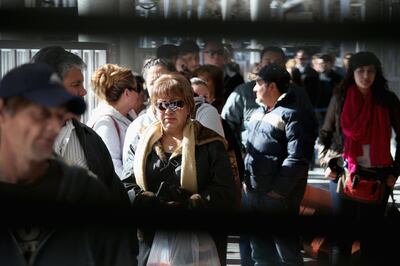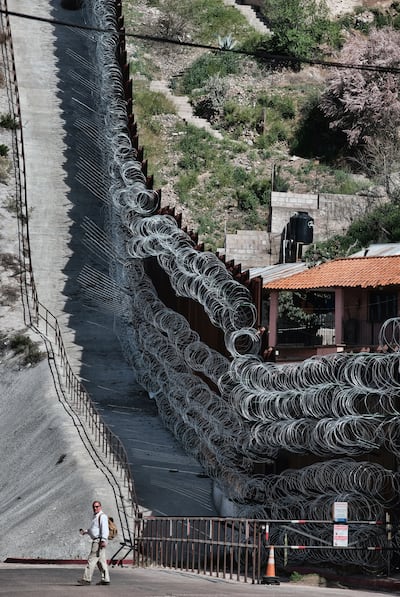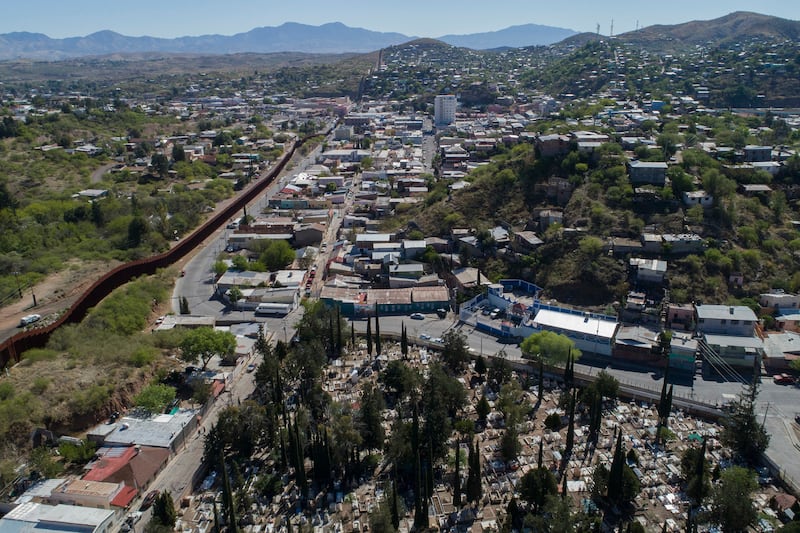Sunlight hits the desert scrub just beyond a cleft in the steel wall that divides the two cities of Nogales — one in the United States and the other in Mexico. It’s strange seeing a single trace of light in a land that is often awash with the sun, but at just the right time in the morning, it creeps in and bursts through the border wall’s gap, funneling out the other side, appearing almost miraculous.
The things the light cannot yet touch are strewn about, like offerings in front of the wall. Coils of concertina wire. Abandoned blankets and beanies coated in the frost of the desert’s dark. An empty glass jar of baby food. Telephone cards. A small book — “Guía Práctica para el Rezo del Santo Rosario” — which translates to a “Practical Guide to Praying the Holy Rosary.” These left-behinds likely belonged to migrants who cut through the Arizona-Mexico border in search of asylum by way of this gap in the wall, known as the “Mariposa Slab.” For many state and federal politicians — including both candidates in the upcoming presidential election — it also represents the core of a national problem.
All ports of entry in Nogales fall under the Tucson Sector of the United States Customs and Border Protection, which covers about 260 miles east to west — some of the busiest territory in America for illegal crossings and drug seizures. Recently, it’s become even busier. There were 80,814 reported migrant apprehensions in the Tucson Sector last December, a 262 percent increase from the previous year. That historic surge prompted President Joe Biden to begin building closures along the border, despite campaigning on a promise that he wouldn’t add “another foot” to former President Donald Trump’s wall construction. Some ports closed altogether out of overwhelm — like the Lukeville Port of Entry, about 200 miles west of Nogales, which shut down for a month in December. The number of migrant apprehensions has ebbed and flowed since. Tucson Sector totals neared 42,000 in March tamped down by increased surveillance on both the Mexican and American side of the border that came as a direct response to the December rush. But despite the recent dwindle, border crossings are expected to rise again, and they remain a focal point in the lead-up to the 2024 presidential election.
A bipartisan bill pushed by Biden in Congress this year would have permitted the government to shutter the border if more than 5,000 migrants crossed it illegally in a single day. For reference, last year brought some one-day totals of more than 10,000. The bill died in the Senate after Republican House leaders pointed out loopholes that would prevent shutdowns and give too much authority to Homeland Security Secretary Alejandro Mayorkas, but it lives on as a campaign point for Biden. In February, the same month Biden’s bill failed, House Republicans voted to impeach Mayorkas in an unprecedented move that was dismissed by the Senate two months later. Each of these opposing steps, made in the name of immigration reform, have ended in gridlock. Democrats are currently scrounging for an alternative plan to replace the defeated bill as all-eyes-on-it attention is on the politics of the border and the migrants who cross it. Yet little attention is paid to the life lived — and shared — in border communities most impacted by changes in policy.
It is in these small communities where the wall is not seen as a symbol of literal and political division, but a doorway that connects rather than separates. “Most of the people who are crossing the border in Nogales, they are locals who have border crossing cards or a special type of visa for binational residents, and they do it every day,” says Ieva Jusionyte, a legal and medical anthropologist who teaches international security at Brown University. “The border depends on circulation.” Nogales, the “gateway to North America,” demonstrates that neither Mexico nor the United States is a monolith — and that the intersection of the two is more of an interconnection.
“Washington cannot dictate our city from sitting behind the desk and not talking to us — I wish the federal people that run the country from over there would take us into consideration.”
In Nogales, Sonora, colorful homes are scattered like confetti among tawny hills. There’s a rhythm and bustle of passersby beyond the turnstile at the Dennis DeConcini Port of Entry in downtown Nogales, Sonora. This city is far larger than its Arizona counterpart, with some 265,000 people compared to 20,000.
Dental and medical offices pepper the streets. There’s “Dental Laser Nogales,” “West Dental,” “Nogales Dental Advanced” and “Arizona Dental Nogales,” each only about five minutes apart. A chorus of storefronts advertise services for Americans in search of cheaper health care — mostly in English. Many even accept American insurance. The familiarity is enough to create the illusion that one did not cross an international border. In truth, much of the city’s downtown is catered to tourists, medical or otherwise. Cow skulls, embellished cowboy boots, sombreros, wrought-iron sculptures and tiny bobblehead turtles perch on shelves and are placed hopefully in front of shop doors.

Part of this focus on American visitors is the undeniable boon of their USD-fueled business. The Mexican city of Nogales brings in more than $450 million in international sales annually. More than 100 manufacturing plants, exporting goods from computers to car parts, contribute the majority of that revenue. The rest relies on steady foot traffic crossing the border. “The majority of clients are Americans here, about 70 to 80 percent,” says Silvestre Castro, the head waiter at La Roca, a restaurant a quick walk from the port. (He’s worked there for 30 years. Every day, he wears an ironed suit and tie to wait on American customers — which he says is his favorite part of the job.) Luz Amelia, who owns the Panadería La Espiga de Oro bakery less than one mile from La Roca, tells a similar story. “A lot of Americans come to the bakery and bring the bread back home as far as Phoenix or Las Vegas,” she says. Amelia orchestrates the orders from behind the counter, with an open binder of decals and designs for custom cakes in front of her while a line of customers clutching their pastries wait to pay with both Mexican pesos and American dollars.
For all the merchants in Sonora who count on sales to Americans, locals in the U.S. are arguably even more dependent on tourists who cross north into Nogales, Arizona. When the pandemic shut down the border, Evan Kory called it a worst-case scenario. The shoe store and bridal shop his family owns on Morley Avenue, La Cinderella and Kory’s Bridal, lost as much as 30 percent in sales. They couldn’t afford to hire employees, so family members took on shifts, keeping the stores open for a few hours at a time.
The shops fully reopened in 2021, offering the family a much-needed financial reprieve until the Lukeville border closed in December. Overcrowding caused wait times in Nogales to jump from an average of half an hour to three hours. Shoppers were disincentivized from crossing into Arizona from Mexico and once again, life appeared dire. “It was excruciating. And we didn’t even care about the fact that the business was struggling,” Kory says. “It was more about, where are the people? We’ve lost who we are.”
Despite the all-eyes-on-it attention being paid to the politics of the border, little is given to the life lived — and shared — in border communities most impacted by policy.
The main reason for the visible crisscross of languages, currencies and cultures in Nogales is a history that predates the border. Anasazi, Hohokam, Apache and Yaqui tribes lived in the region long before European settlers, with the Nogales area serving as a stop on a trade route that bridged Indigenous communities — setting the foundation for the binational nature of Nogales that persists today. It was only after the Gadsden Purchase in 1853 that the two sides were definitively and finally bisected into separate settlements.
Still, the two cities are often referred to as one, as “Ambos Nogales,” or “both Nogales.” The first chain-link fence that ran through them was put up during the Mexican Revolution in 1915; something to draw a new line in the sand, though crossings were common and uneventful since families spanned across either side. A spirit of unity — even at the official level — persisted regardless. “A collaboration between fire departments was older than the border fence,” Jusionyte, the professor at Brown University, says. She has also volunteered as a first responder in Nogales, and authored the book “Threshold: Emergency Responders on the US-Mexico Border.”
Today — despite the barbed wire and towering steel structures that stand in place — the same is true. Data from the Government of Mexico shows more people have come from the United States into Nogales, Sonora, in the last five years than from anywhere else. Most of these visits are to see family. “You have all these people whose lives are on the border … not divided by the border, but united by the border,” says Randall H. McGuire, an archaeologist who has researched and worked in Nogales, Sonora, for four decades. “It’s often regarded as the most integrated of border communities on the U.S.-Mexican border. It was the only one that was built with the downtowns facing each other.”
When borders close and policies change, families are separated. Castro tries to go to Nogales, Arizona, with his 16-year-old a few times a month to shop and to visit his uncles and cousins in Phoenix. Amelia tries to cross at least once a week to spend time with her three sons in Nogales, Tucson and Phoenix. However, with the election looming and border policy dominating the national agenda, it’s crossed their minds that their access could change. “People outside of the border region just can’t seem to wrap their head around the fact that it’s possible to be binational as a person,” Kory says. “Nogales really is that way.”

Fernando Urias, battalion chief of the Nogales Fire and Medical Department in Arizona, references the modern history that both cities share. He can cite several examples of fire suppression efforts that have continued to cross the border in his 20 years in the department. The most famous took place a dozen years ago when a hotel caught fire just beyond the border in Sonora. Firefighters from Arizona stationed a fire truck beside the fence and lifted a crane across to douse the flames with jets of water. The image circulated nationally. It depicted a clear moment of solidarity despite the obvious barrier below. The aid has been reciprocated. When another emergency broke out on the Arizona side of the fence some years later, the volunteer firefighters, or bomberos, responded. They arrived in a pickup truck to put out a residential fire that had spread from one house to five. “If you told somebody that, they would probably think you’re telling a tale, but that’s how it went down,” Urias says. “They showed up in the back of a truck and got to work.”
For both sides, living on the border means fires — literal or otherwise — are shared. But Urias now fears that political tensions could stand in the way of communities, families and officials coming together. “I think times have changed,” he says. “Not saying that it can’t happen, I just don’t foresee it happening with all the politics.”
Some border states have grown so tired of not feeling heard by the federal government that they’ve pushed to circumvent it altogether. In Texas, a law that went into effect in March makes illegally crossing the border a state crime and gives local law enforcement the authority to arrest migrants. “Washington cannot dictate our city from sitting behind the desk and not talking to us — I wish Washington and the federal people that run the country from over there would take us into consideration,” says Jorge Maldonado, mayor of Nogales, Arizona. To him, policy and politics bring awareness to issues, but not the complexity of those issues.
“For too long, we all know the border’s been broken,” Biden said during an attempt to rally support for his bill. Over 2,000 miles away from D.C., that brokenness — the gaps in border policy — are manifested in literal gaps like the Mariposa Slab, functioning as an albatross of sorts: What were once considered doorways have become holes. But once they are sealed, what comes next? The Mariposa Slab looms on the periphery, and every morning, the sun shines through that gap into an uncertain future.
This story appears in the June 2024 issue of Deseret Magazine. Learn more about how to subscribe.


